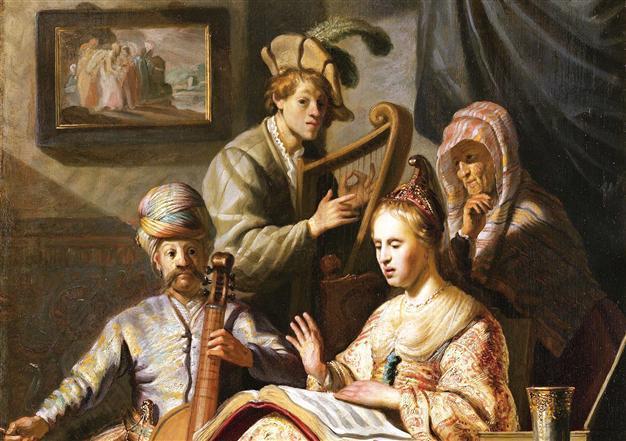Rembrandt finds place in Dutch - Turkish relations
NIKI GAMM ISTANBUL- Hürriyet Daily News

The photo above shows Rembrandt’s ‘The Music Lesson’ which is on display at the Sakıp Sabancı Museum. The other photo shows the first Dutch ambassador, Cornelis Haga.
The Dutch master Rembrandt was just 20 years old when he painted “The Music Lesson” in 1626. But what is of interest in the painting is not the four people portrayed or the books so casually jumbled on the floor. One should look closely at the clothing which is not Dutch but Ottoman Turkish.
“Rembrandt was a keen observer and collector. In his time, the import of Turkish goods, textiles, carpets and weapons reached its peak,” Sabancı Museum Director Dr. Nazan Ölçer said in response to a question concerning “The Music Lesson,” which is currently on display at the Sakıp Sabancı Museum. “Therefore, we can argue that the Orientalist elements in his paintings are realistic.”
Official ties between the Netherlands and the Ottoman Empire began with the appointment of Cornelis Haga as the Dutch ambassador to the Sublime Porte, as the Ottoman central government was generally called. He arrived in Istanbul on March 14, 1612, and quickly proceeded to negotiate the capitulation of 1612 granting the Dutch legal, fiscal and commercial privileges which the Venetians, French and English had previously received. 2012, thus, is the 400th anniversary of that grant.
Relations between the two states had started earlier on an informal basis because of a mutual enemy, Spain, but that and the many “pirate” ships loyal to the Sublime Porte had not stopped Dutch merchant ships from navigating the Mediterranean Sea. The capitulation gave Haga the right to establish consulates in order to promote trade and encourage free shipping throughout the Middle East.
Portrayal of figures Trade between the Ottomans and Europe had been handled via Venice and other Italian states; however, the Dutch, like merchants from other countries, were eager to grab some of that lucrative trade for themselves.
As Fernand Braudel writes in his epic work on the 16th-century Mediterranean, “The appearance of the northern sailing vessel of 100 to 200 tons, well armed and easily maneuvered, marks a turning point in maritime history.”
No matter what happened in the future, the Dutch had securely established themselves as merchants in the Mediterranean. They were heavily involved in the grain trade and other trades. Moreover, they had an advantage at times over their rivals by being able to buy merchandise with cash.
For anyone particularly interested in the relationship between the Dutch and the Turks, the exhibition “Sultans, Merchants, Painters: The Early Years of Turkish – Dutch Relations” is currently on at the Pera Museum until April 1, 2012.
The portrayal of Ottoman figures, clothing and scenes in European paintings can be attributed to the visit of Gentile Bellini in 1479-1480 to Istanbul at the invitation of Mehmet the Conqueror. When the artist returned to Italy, he painted many figures in Turkish dress in his works and these served as models for other, later artists.
The attitude of the Europeans was ambivalent. On the one side there was fear concerning an Ottoman conquest of Europe and on the other, there was curiosity. The latter was piqued through the importation of Turkish goods such as silk and brocade garments and the many stories told and pictures drawn by people who had actually visited the Ottoman Empire.
Motifs appear in objectsRembrandt, however, never went to the Middle East and did not study with artists in Italy. But as a result of the capitulation signed between the Ottomans and the Dutch, an increasing number of carpets, metals and ceramics began to reach the Netherlands and Ottoman motifs began to appear in various art forms such as in the tiles and ceramics produced in Delft. In turn, the Ottomans so liked the Delft designs that they covered the walls in some of Topkapı Palace’s harem rooms with Delft tiles.
At the same time that trade was increasing, Ottoman styles of clothing were attracting attention. It is highly unlikely that any actual examples still exist in Europe prior to the 16th century. Travelers and ambassadors brought examples to Europe. There also existed books containing pictures of Ottoman men and women wearing uniforms or clothing that proclaimed their rank or status. So it is not surprising that Rembrandt painted the four people in “The Music Lesson” in Ottoman garments. The man playing the bass violin is not just wearing a turban and an entari; prayer beads can be seen peeking out from his sash. The woman is also wearing a hat or headdress that resembles a type known to have been worn in Topkapı Palace in the early 17th century. Under the circumstances, it is not surprising that Rembrandt chose to depict a popular subject.
